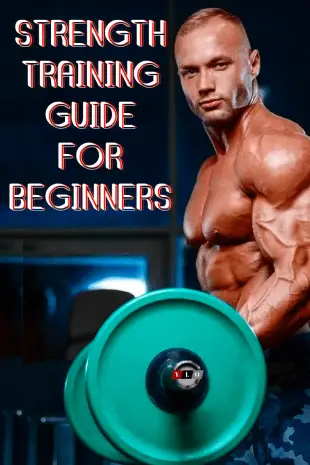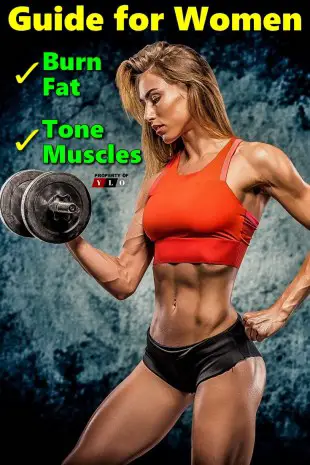Strength training programs are a time-tested and proven method of building muscle, burning fat and gaining strength simultaneously, all the while making improvements to cardiovascular health.
Fitness Trends
Fitness trends come and go as the years pass by, gaining popularity and eventually fading away. Strength training programs have been around just as long as human fitness has, and will continue to stand the test of time.
Athletes, bodybuilders, and powerlifters know the benefits of strength training programs. Strength training will undoubtedly be the best method of preserving muscle while being on a low-calorie diet. It works on improving stabilizer muscles, burning calories and using the most efficient movements in the shortest amount of time.
Training for strength will also increase muscle mass and help you burn fat due to its use of compound exercises which utilize 2 or more muscle groups at a time, kicking your metabolic rate into high gear.
Sets and Reps
When working out, you will be basing your routine around both sets and reps. Reps are short for repetitions which refers to how many times you will be performing the movement. Sets are how many times you will be performing a set of repetitions.
There are many combinations of sets and reps, like the popular 3 sets of 10, commonly written 3×10. Three general repetition combinations are used when planning a workout.
• Sets of 12 or more will generally be used with lighter weights and will gear more towards muscular endurance.
• Sets of 8-12 will be used with moderately heavy weights and will benefit muscular hypertrophy, or the breaking down of muscle tissue to rebuild more lean muscle mass.
• Training for pure strength will put you in the 1-6 rep ranges. The lower the repetitions, the higher the weight is used.
• Lastly, a 1 repetition set will generally be your max weight possible on a given exercise.

Full Body Workout for Strength Training
A great and efficient way to utilize strength training is to develop a full body workout using the primary compound lifts with the tools mentioned below, and any proper guide to strength training programs would be remiss to not mention these.
There are many different methods you can use to build your perfect strength training program, so let’s go over some of the different tools you can use to pack on that glorious muscle.
Barbells
Barbells are the old time lifters favorite tool. With a single barbell and the right amount of weight, you can design a workout that will target every single muscle in the body. A standard barbell weighs 45 pounds and can support roughly 7-800 pounds.
With a barbell, you can do all the most important compound lifts which will provide you with the greatest workout. Barbells are designed to be loaded with weight and held with both hands during movements.
Dumbbells
Similar to barbells, dumbbells are a fantastic addition to any weightlifting routine and strength training program. They can be just as effective as a barbell but you might not be able to hit your target weight as easily. Barbells can go up and down over a hundred pounds or even be used with 5 or 2.5-pound plates, while dumbbells are usually set in their weight unless it is adjustable.
A single barbell can replace an entire rack of dumbbells, but dumbbells do have the option of being used with greater mobility instead of a set bar path. Dumbbells are made to be used by one hand.
Resistance Bands
Resistance bands are great for beginners and those who are trying to become accustomed to the movements done with barbells and dumbbells. The thickness of a resistance band denotes how difficult it will be to move.
Thicker bands provide more tension, while thinner bands are designed perfectly for those who wish to begin workouts using a lighter weight.
Machines
Machines were originally designed to be used by people with injuries or pre-existing health conditions which would stop them from using a barbell or dumbbell. Machines are great for isolating muscle groups such as biceps or triceps, but can also be used for compound movements like the bench press or cable row.
The one downside to using a machine is that it eliminates your bodies need to stabilize the weight, which can cause your stabilizer muscles to become underdeveloped if not included in your workouts. The smith machine, for example, has a light barbell moving up and down on a fixed plane, which would stop your muscles from needing to balance and steady the weight, unlike a regular barbell or dumbbell. This would enable you to lift more weight but at the cost of developing an unbalanced physique.
A great benefit of machines is that they are safe to use. Heavy compound lifts with barbells and dumbbells can be dangerous without a spotter. A machine takes most of the risk out of the equation and is a great tool for the solo lifter.
Suspension Trainers
Suspension trainers are bands that can be hung from a pull-up bar or similar apparatus which loop around your arms, allowing you to be suspended in mid-air. These bands are fantastic for body weight movements and abdominal workouts such as the hanging leg raise. You could even strap in your feet and hang upside down to get the perfect range of motion on a sit up!
4 Excellent Exercises for All Strength Training Programs
Deadlift
The deadlift is known as the king of exercises. This movement is simple to learn but difficult to master, especially when using heavy weight. The deadlift works nearly every muscle in the body, including the quads, glutes, hamstrings, upper and lower back, biceps, traps, and abdominals.
You start with a barbell resting on the floor. Step in front of the barbell, squat down keeping your lower back as straight as possible and proceed to lift the weight off the floor, pulling it up your shins until you stand up straight.
This movement can be very taxing on the central nervous system so it’s important not to load up too much weight if you’re tired, sore, haven’t gotten enough rest or are lacking energy from restricting calories.
Although it’s a simple movement, you can be very prone to injury if you do not stabilize your lower back during the lift. If your lower back becomes rounded, it will bear the full weight of the bar instead of distributing it between your upper and lower body. Make sure you are tightening your midsection and keeping your back straight!
Squat
Like the deadlift, the squat is another excellent compound movement utilized by athletes in all sports. The squat will strengthen your lower body, lower back and core muscles all while increasing explosiveness and speed. Squats done for higher repetitions in the 12+ range while using moderate to heavy weight will also greatly speed up your heart rate and boost that metabolic burn.
To perform a squat, have a barbell on a rack or pins at roughly the height of your shoulders and upper chest. Step under the bar with both legs, balancing it across your upper back and lift up. Make sure you are at the center of the bar, not too much to the left or right.
Back up from the rack and begin to stabilize your core by tightening your abdominal muscles. The biggest mistake one can make during the squat is to lean forward when going down. This puts an enormous amount of stress on your lower back and will cause you to become off balance.
When you are going down on a squat, you want to replicate the motion of sitting in a chair. Bring your butt back first and keep your knees and ankles aligned as best you can. Tighten your core and sit in that imaginary chair. When your quads and calves form a 90-degree angle, explode back up, rinse and repeat.
Some advanced lifters like to perform deep squats to where their glutes are nearly touching the floor. This form of squat is great for building an explosive base, but as a beginner lifter, it’s best to master the basic form of the movement before moving to an advanced routine.
A squat/deadlift dumbbell variation can be used by holding the dumbbells at your side, above your head or even resting on your shoulders in lieu of a barbell.

Bench Press
The almighty bench press comes in 3 distinct variations to work different portions of the chest and is the greatest chest exercise you can add to a workout.
An incline bench press has you sitting on an upright plane to where your chest is above your waist. The incline bench press primarily works the upper portion of the chest, the same portion that can be targeted with the overhead press, which is the next exercise we’ll cover in the beginner’s guide to using strength training programs.
The flat bench press is the most common form of benching you will see performed at the gym and is essentially the jack of all trades which will target the upper, middle, lower, outer and inner portions of the chest. As the name implies, you will be laying on a flat bench while performing this movement.
Last but not least is the decline bench press, which is where your chest will be below your waist. The decline variation of the bench press will target the lower chest, which is the part of the chest which consequently carries the most body fat, so it’s important to integrate this movement into your routine. Do not leave out the decline bench press from your strength training programs – many forget to include it.
Overhead Press
The overhead press is the primary compound movement for the shoulder muscle. Depending on how far back you lean while pressing, you can also target a bit of the upper chest.
Another simple movement, if using a barbell, will be positioned similar to that of a squat, on a rack or pins near your upper chest. Step underneath the bar, gripping with both hands and remember to once again stabilize and tighten your midsection during the lift.
Simply press the bar above your head and lower it back down. Using wrist wraps to stabilize your wrist joints can be very helpful when overhead pressing, as heavier weights can cause pain in the wrist joint if you allow it to bend too much.
As with the squat, deadlift and bench press, the overhead press can also be done using dumbbells or machines which mimic the movement.
Warming Up Before Strength Training
Stretching and warming up before jumping into working with heavy weights is crucial. Warming up with lighter weights will increase blood flow to the muscle which effectively “wakes it up”, engaging it and preparing it to handle heavier loads.
Compound movements when done properly engage more than a single muscle group which means you are doing more work per movement, increasing your results drastically.
Compound movements can also leave you more prone to injury than other exercises, so as a beginner to strength training it is of the utmost importance that you use a weight you are comfortable with and maintain proper form. You won’t be building a lean, muscular physic if you’re injured!

Accessory Movements in Strength Training Programs
Accessory movements can also be added into a good full body routine which includes bicep and tricep exercises such as the bicep curl or tricep extension, calf raises, forearm curls and abdominal exercises like the crunch and sit-ups.
Doing a full body compound workout with some added accessory movements will help you develop a strong, balanced physique while also building up your central nervous system, increasing your strength capacity and engaging your cardiovascular system by increasing your heart rate.
It truly is the most effective workout for both beginner and advanced lifters. A good full body routine can be performed 3 times a week, generally resting at least 1 day between each workout. Remember, safety is of the utmost importance.
As a beginner to strength training programs, you will notice your body adapting to each of these movements over time. When performing a movement, especially a compound movement for the first time, it can feel a little awkward as your body gets used to handling the weight and a specific activity at the same time.
You might feel slightly off balance when performing these movements as a novice but if you stay consistent, you will adapt, grow and become accustomed to exercising. The human body was made to stay active and in shape, and you will experience many positive changes once you start reducing body fat and packing on lean muscle.
Depending on how much weight you use, you will generally want to rest 1-2 minutes in between sets, which is known as your rest interval. If you are going for pure strength gains in the 1-6 rep range, you could even rest 3-5 minutes in between sets.
Learn to listen to your body and continue when you feel rested and replenished.

Benefits and Diet
Some of the benefits you will experience with strength training are:
• Increased muscle mass
• Increased strength
• Greater athleticism
• Greater muscular endurance
• Better cardiovascular health
• Lower blood pressure and resting heart rate
• Stronger central nervous and immune systems
• Stronger Bones
• Reduced effects of aging
• Improved stability, flexion, focus, coordination and much more!
When reading any guide on strength training programs, many people will ask if such training will cause them to become bulky or overly muscular, as many prefer to stay lean and keep the athletic, aesthetically pleasing physique. Not to worry!
Unless you are in a high caloric surplus, commonly called a “bulking phase” by most bodybuilders, you don’t have to worry about getting too big. The number of calories we take in each day will determine if we gain weight, lose weight or maintain our current weight.
There are many online calculators for determining how many calories you need. It will depend on your height, weight and activity level. If you are staying underneath your caloric needs, you will not become too big or bulky while also keeping body fat off.
As a matter of fact, strength training programs, when coupled with a good diet plan, is actually one of the most effective ways of losing weight! Compound movements are without a doubt the most effective movements for increasing your metabolism and burning fat. Compound movements will also greatly increase the number of calories you burn after the workout when you are resting, also known as the afterburn effect.
Remember, while this guide to strength training programs outlines the benefits and importance of integrating weightlifting into your fitness routine, you can never outwork a bad diet.
A fit physique is made in the kitchen as many say, and a healthy balanced diet of whole grains, lean meats, healthy fats alongside fruits and vegetables is crucial to burn fat and see the lean muscle you have been packing on in the gym.
Stay consistent, eat healthily, incorporate proper weight training and you will have the body of your dreams in no time!
From the pages of Time Magazine: How Strength Training Changes Your Body For Good
A helpful article by WebMD: The Basics: Build Muscle for Better Health



